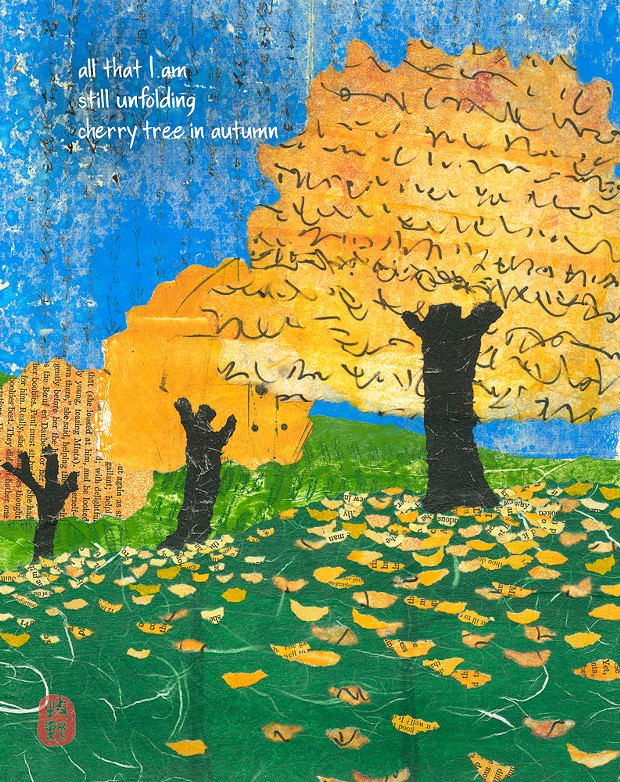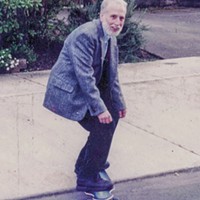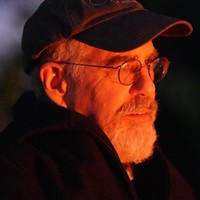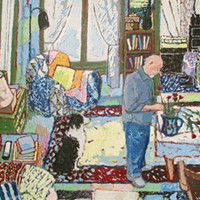
Annette Makino's "All that I am" incorporates book pages, a fern print, a vintage Japanese letter and washi paper, as well as asemic, or made-up, writing by her nephew.
[
{
"name": "Top Stories Video Pair",
"insertPoint": "7",
"component": "17087298",
"parentWrapperClass": "fdn-ads-inline-content-block",
"requiredCountToDisplay": "1"
}
]
Annette Makino has been an artist all her life but it wasn't until 2010 that she became interested in incorporating haiku into her artwork. For her birthday that year, her Arcata friend and fellow artist Amy Uyeki gave her a book of senryu, a poetic form structurally similar to haiku but with more humor and a focus on human nature. The poems were written by Uyeki's Japanese grandmother and accompanied by Uyeki's art.
"This lovely book set me on my current path," says Makino, whose father is also Japanese. She started combining her haiku with simple brush paintings, which evolved to Asian-inspired watercolors and then collages. A year later, after leaving her 20-year career as senior vice president for communications at the Arcata-based nonprofit Internews, she launched Makino Studios, offering collages, watercolors, prints, cards and calendars.
Currently she works mostly with collage using hand-painted and torn Japanese washi papers, which are typically made from the fibers of the mulberry plant. She also uses other papers from different parts of her life — letters, her young nephew's scribbles, book pages, musical scores and maps. To make sure the pieces don't fade over time, she uses acrylic paints to color the white paper, then tears it into the shapes she wants and glues it onto paper or wood, a process that typically takes two to three days. According to Makino, a common misconception is that collage doesn't require much skill. "It's very labor intensive and can involve as much skill as painting," she says.
Makino's most productive periods of artwork happen twice every summer, when she and her husband, Paul, a retired Cal Poly Humboldt geography professor, rent a cabin on the Klamath River in Orleans, a place they've visited for 27 years. In that placid location, free from distractions, she can get a lot of work done.
Makino usually writes the haiku first, before the artwork. "The words aren't meant to illustrate the art," she says. "You want a bit of distance, so the reader has a new way to think about the theme." She often starts crafting the poem while hiking in Ma-le'l Dunes or in Trinidad, where she and Paul walk a couple of times a week.
Makino considers herself equal parts artist and writer. Her book Water and Stone: Ten Years of Art and Haiku was awarded Honorable Mention in the Haiku Society of America's Merit Book Awards and her poetry regularly appears in English-language haiku journals, including Modern Haiku, Frogpond and The Heron's Nest. She has also won awards for her poetry from the Haiku Foundation and the Haiku Society of America.
Many of Makino's haiku have to do with transitions. A few years ago, for example, when her two young adult children started the process of leaving home, she wrote about the empty nest, while the loss of her 16-year-old dog inspired many poems last summer. Her 95-year-old mother Erika, a former Humboldt resident and also a writer and artist, lives three hours away in Mendocino County. Makino visits her about once a month and is keenly aware of her mom's gradual decline. That, and the earthquake last winter which caused a lot of damage to her home, have inspired her poetry and art. "Whatever life brings me," she says.
Makino was one of five local artists granted the 2022 Victor Thomas Jacoby award for "artistic vision and creativity," provided annually by the Humboldt Area Foundation and Wild Rivers Community Foundation. Winners each received $10,000 to support their work. The award freed her from some of the commercial pressures of running a business and creating mostly marketable art that appeals to the public. Instead, she experimented with mixed media, using materials like charcoal, crayon, ink and pencil in her collages, and exploring oils and cold wax. Recently, she's been incorporating more personally meaningful elements into her collages. Because Paul loves maps, she created a collage for him that included a detailed map of Tibet. Another collage she created with whales incorporated a scrap from her daughter's high school copy of Moby Dick. For "Garden rosebush," she says, "I included a letter from my Swiss grandmother when I got married."
Makino's Japanese-Swiss ancestry has shaped her creativity. The haiku and Japanese paper may be more apparent to viewers but, "The Swiss, too, are surprisingly very playful in their art and writing," she says, noting she likes to bring that spirit of play into her work.
Makino's cards, prints and calendars are available at the Made in Humboldt Fair at Pierson Garden Shop through Dec. 24, and in shops around the county year-round. You can see more of her work at makinostudios.com.
Louisa Rogers (she/her) is a writer, painter and paddleboarder who lives in Eureka and Guanajuato, Mexico.
Speaking of...
-

Won't Fade Away
Feb 1, 2024 -

Open-Air Poetry Reading with David Holper
Sep 28, 2023 -

Ruth Arietta's Illusory Interiors at Morris Graves Museum of Art
Aug 10, 2023 - More »
more from the author
-
Anna Oneglia: Humboldt's Traveling Artist
- Oct 12, 2023
- More »
































